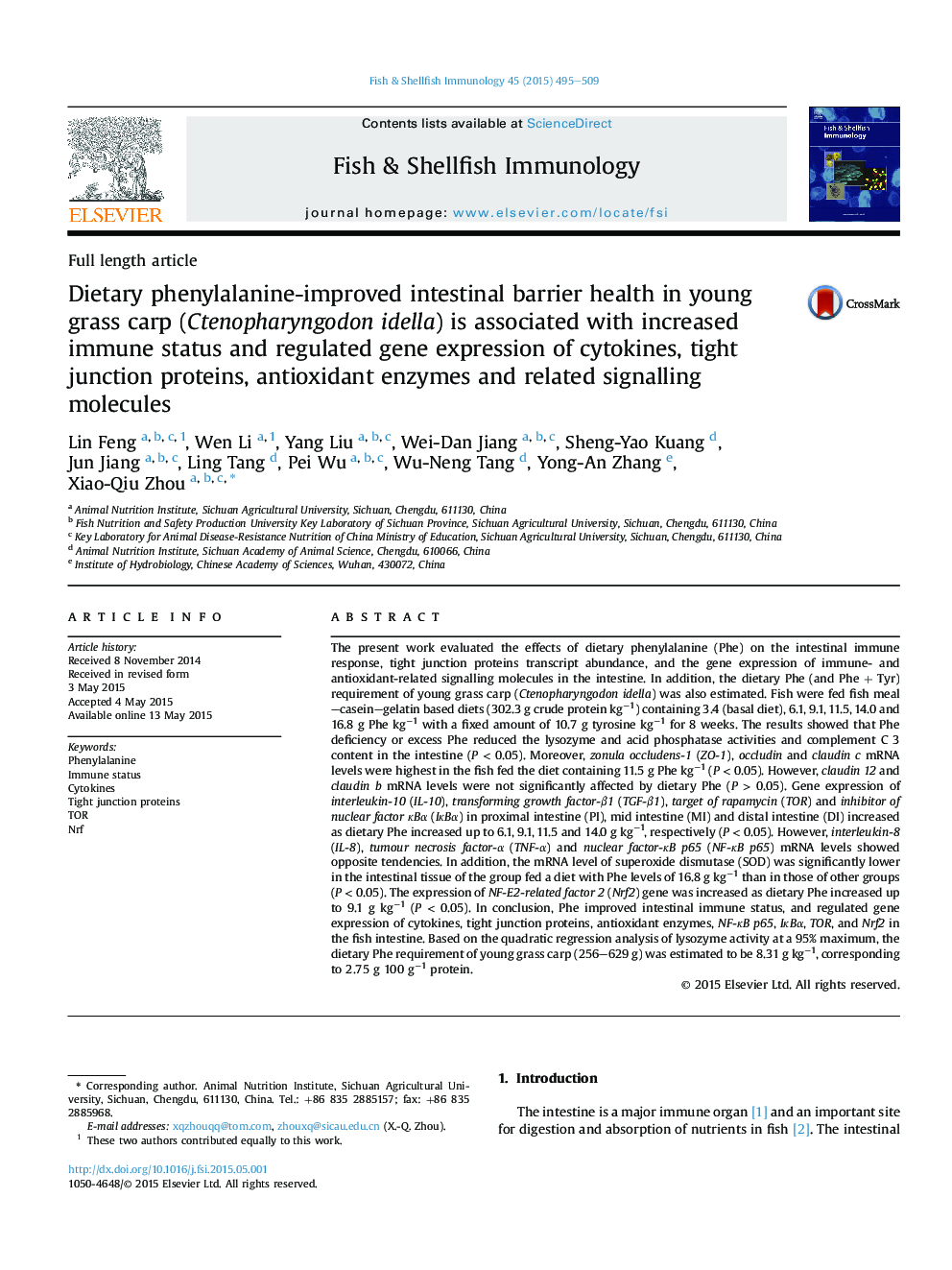| Article ID | Journal | Published Year | Pages | File Type |
|---|---|---|---|---|
| 10971827 | Fish & Shellfish Immunology | 2015 | 15 Pages |
Abstract
The present work evaluated the effects of dietary phenylalanine (Phe) on the intestinal immune response, tight junction proteins transcript abundance, and the gene expression of immune- and antioxidant-related signalling molecules in the intestine. In addition, the dietary Phe (and Phe + Tyr) requirement of young grass carp (Ctenopharyngodon idella) was also estimated. Fish were fed fish meal-casein-gelatin based diets (302.3 g crude protein kgâ1) containing 3.4 (basal diet), 6.1, 9.1, 11.5, 14.0 and 16.8 g Phe kgâ1 with a fixed amount of 10.7 g tyrosine kgâ1 for 8 weeks. The results showed that Phe deficiency or excess Phe reduced the lysozyme and acid phosphatase activities and complement C 3 content in the intestine (P < 0.05). Moreover, zonula occludens-1 (ZO-1), occludin and claudin c mRNA levels were highest in the fish fed the diet containing 11.5 g Phe kgâ1 (P < 0.05). However, claudin 12 and claudin b mRNA levels were not significantly affected by dietary Phe (P > 0.05). Gene expression of interleukin-10 (IL-10), transforming growth factor-β1 (TGF-β1), target of rapamycin (TOR) and inhibitor of nuclear factor κBα (IκBα) in proximal intestine (PI), mid intestine (MI) and distal intestine (DI) increased as dietary Phe increased up to 6.1, 9.1, 11.5 and 14.0 g kgâ1, respectively (P < 0.05). However, interleukin-8 (IL-8), tumour necrosis factor-α (TNF-α) and nuclear factor-κB p65 (NF-κB p65) mRNA levels showed opposite tendencies. In addition, the mRNA level of superoxide dismutase (SOD) was significantly lower in the intestinal tissue of the group fed a diet with Phe levels of 16.8 g kgâ1 than in those of other groups (P < 0.05). The expression of NF-E2-related factor 2 (Nrf2) gene was increased as dietary Phe increased up to 9.1 g kgâ1 (P < 0.05). In conclusion, Phe improved intestinal immune status, and regulated gene expression of cytokines, tight junction proteins, antioxidant enzymes, NF-κB p65, IκBα, TOR, and Nrf2 in the fish intestine. Based on the quadratic regression analysis of lysozyme activity at a 95% maximum, the dietary Phe requirement of young grass carp (256-629 g) was estimated to be 8.31 g kgâ1, corresponding to 2.75 g 100 gâ1 protein.
Related Topics
Life Sciences
Agricultural and Biological Sciences
Aquatic Science
Authors
Lin Feng, Wen Li, Yang Liu, Wei-Dan Jiang, Sheng-Yao Kuang, Jun Jiang, Ling Tang, Pei Wu, Wu-Neng Tang, Yong-An Zhang, Xiao-Qiu Zhou,
